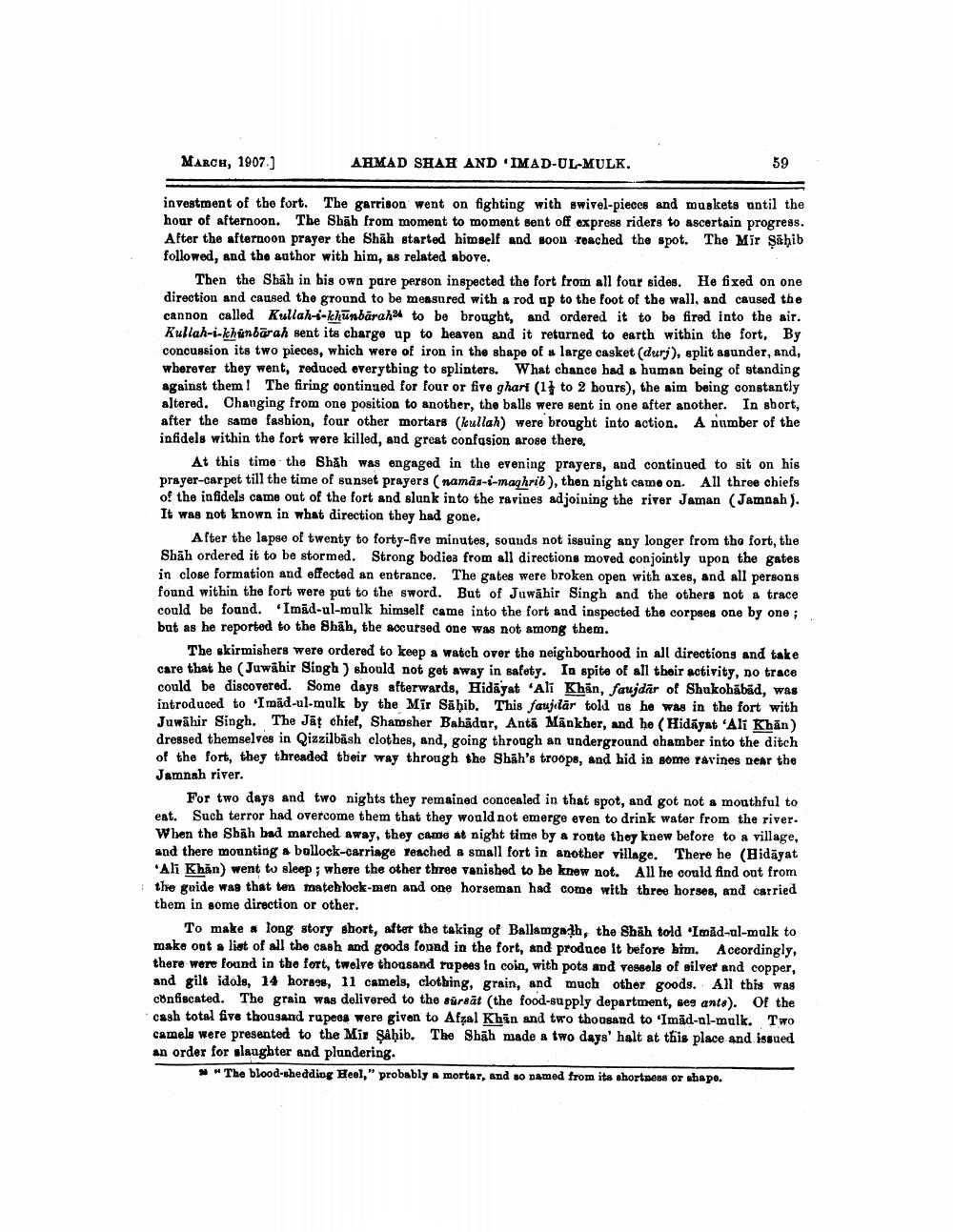________________
MARCH, 1907.]
AHMAD SHAH AND IMAD-UL-MULK.
investment of the fort. The garrison went on fighting with swivel-pieces and muskets until the hour of afternoon. The Shah from moment to moment sent off express riders to ascertain progress. After the afternoon prayer the Shah started himself and soon reached the spot. The Mir Sahib followed, and the author with him, as related above.
59
Then the Shah in his own pure person inspected the fort from all four sides. He fixed on one direction and caused the ground to be measured with a rod up to the foot of the wall, and caused the cannon called Kullah-i-khunbārah to be brought, and ordered it to be fired into the air. Kullah-i-khunbarah sent its charge up to heaven and it returned to earth within the fort, By concussion its two pieces, which were of iron in the shape of a large casket (durj), split asunder, and, wherever they went, reduced everything to splinters. What chance had a human being of standing against them! The firing continued for four or five ghari (1 to 2 hours), the aim being constantly altered. Changing from one position to another, the balls were sent in one after another. In short, after the same fashion, four other mortars (kullah) were brought into action. A number of the infidels within the fort were killed, and great confusion arose there,
At this time the Shah was engaged in the evening prayers, and continued to sit on his prayer-carpet till the time of sunset prayers (namaa-i-maghrib), then night came on. All three chiefs of the infidels came out of the fort and slunk into the ravines adjoining the river Jaman (Jamnah). It was not known in what direction they had gone.
After the lapse of twenty to forty-five minutes, sounds not issuing any longer from the fort, the Shah ordered it to be stormed. Strong bodies from all directions moved conjointly upon the gates in close formation and effected an entrance. The gates were broken open with axes, and all persons found within the fort were put to the sword. But of Juwahir Singh and the others not a trace could be found. 'Imad-ul-mulk himself came into the fort and inspected the corpses one by one; but as he reported to the Shah, the accursed one was not among them.
The skirmishers were ordered to keep a watch over the neighbourhood in all directions and take care that he (Juwahir Singh) should not get away in safety. In spite of all their activity, no trace could be discovered. Some days afterwards, Hidayat Ali Khan, faujdar of Shukohābād, was introduced to Imäd-ul-mulk by the Mir Sahib. This faujdär told us he was in the fort with Juwahir Singh. The Jat chief, Shamsher Bahadur, Antă Mankher, and he (Hidayat 'Ali Khan) dressed themselves in Qizzilbash clothes, and, going through an underground chamber into the ditch of the fort, they threaded their way through the Shah's troops, and hid in some ravines near the Jamnah river.
For two days and two nights they remained concealed in that spot, and got not a mouthful to eat. Such terror had overcome them that they would not emerge even to drink water from the river. When the Shah had marched away, they came at night time by a route they knew before to a village, and there mounting a ballock-carriage reached a small fort in another village. There he (Hidayat 'Ali Khan) went to sleep; where the other three vanished to he knew not. All he could find out from the guide was that ten matchlock-men and one horseman had come with three horses, and carried them in some direction or other.
To make a long story short, after the taking of Ballamgaḍh, the Shah told 'Imad-ul-mulk to make out a list of all the cash and goods found in the fort, and produce it before him. Accordingly, there were found in the fort, twelve thousand rupees in coin, with pots and vessels of silver and copper, and gilt idols, 14 horses, 11 camels, clothing, grain, and much other goods. All this was confiscated. The grain was delivered to the sursat (the food-supply department, ses ante). Of the cash total five thousand rupees were given to Afzal Khan and two thousand to 'Imad-al-mulk. Two camels were presented to the Mir Şâhib. The Shah made a two days' halt at this place and issued an order for slaughter and plundering.
"The blood-shedding Heel," probably a mortar, and so named from its shortness or shape.




